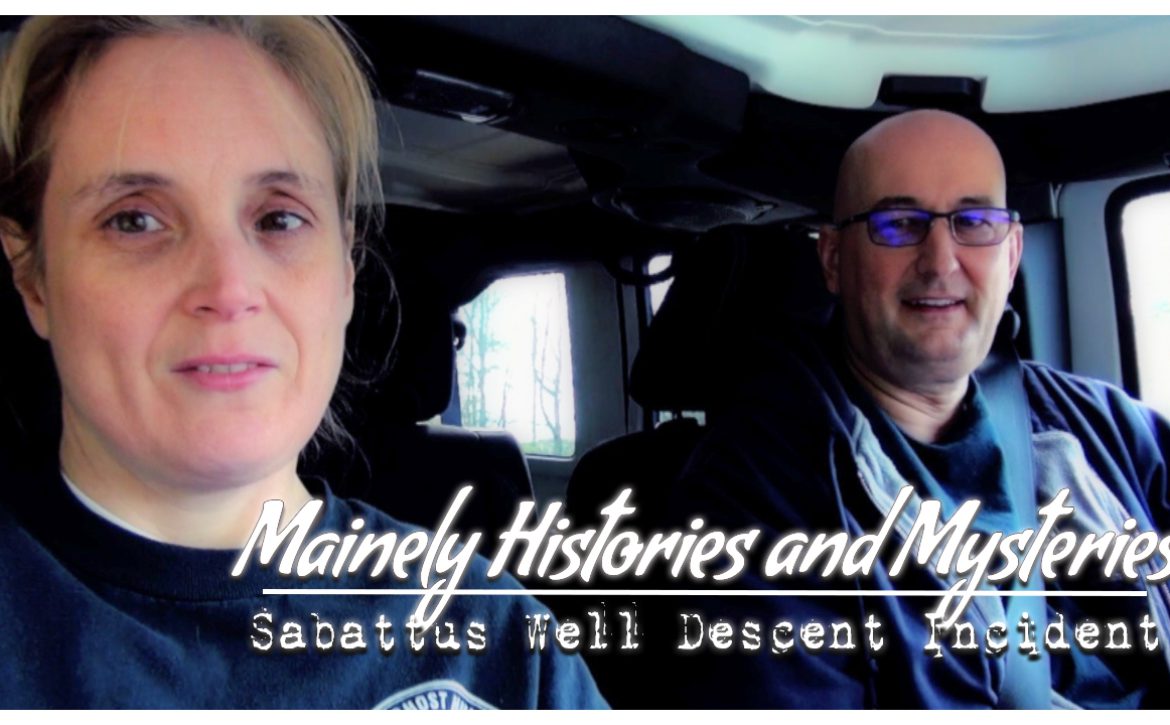Maine’s Lost Governor
He died while in office, was buried with full honors, and his body subsequently – lost… Where did Enoch Lincoln’s body go?
He died while in office, was buried with full honors, and his body subsequently – lost… Where did Enoch Lincoln’s body go?
This legend has been told for decades … but is it true? Join us as we investigate…
Introduction
We’re heading out to the mid-coast town of Edgecomb, Maine. Population 1,200, give or take. There’s a ton of history in this sleepy little community and while most of it’s celebrated, there are some events the locals have lost through time. In this case… have lost on the side of a mountain. A gruesome massacre leaving 6 dead, buried in graves that were dug before the murders took place. These days the story is scarcely remembered by the older generation, but the rumor about town is the killings were done with either a gun or a knife. We’re about to take you back to the 1800’s and tell you exactly what the press and first person witnesses had to say happened at the top … of Mount Hunger.
Historical Information
Mount Hunger is more of a hill than a Mountain, but since it’s the highest point in the area it’s known by the locals as “Mount Hunger”.
Mount Hunger was settled during at time when England needed masts for their ships, so they dropped people off in the New World to cut timber and serve the crown. People originally landed, quite literally, in a place called “Salt Cove” here in Edgecomb, but they quickly made a permanent settlement of houses up on the highest peak in town, and that’s on top of Mt. Hunger. Actually “Salt Marsh Cove” (I added this fact later, on 11-7-2017)
Up on Mt. Hunger there was very little tillable soil. As a matter of fact, when settlers started building houses up here there were no basements dug because they couldn’t get that far down into the dirt before they hit something hard and impenetrable. The people who settled the top of Mt. Hunger were a sort of 2nd generation settler in this region. By the time they got here there was no more land available to buy down by the water, so they had to buy wherever was available and whatever they could afford. These people were foresters and farmers, and that’s important because they’re used to living off the land. They probably weren’t used to making a living off other people, other than selling what they grew or cut.
These are the people that wound up with the land on top of Mt. Hunger.
As already stated, the land lacked planting soil, and so you can bet there weren’t any big trees up there either. This is where the tragedy starts to form.
The earliest settlers landed here by order of King George – be it George II or George the III. The point is, they were here before the Revolutionary war. Which means well before 1776.
By the time this next generation of settlers of Foresters and Farmers had arrived, the plantable land was taken, and all the large pines had been cut and sent off to England to be used as masts in the King’s Navy. So, the people who bought land up on Mt. Hunger were either highly capable at some sort of trade or business that allowed for them to sustain themselves by the work of those in the lower lands, say, for food as an example – since this area *is* called Mt. Hunger – or they were very poor and sustained themselves by means that never really allowed them to get comfortable, let alone “get ahead”. They were always in a life or death game of survival up here by the time the mid 1800’s rolled around.
It’s these circumstances that brought 1 man to commit a travesty unto his own family that was so horrible we’re sure it’s left a permanent mark on this land.
The Tragedy
On May 11, 1848 George W. Pinkham took an axe to his wife and his 4 children. The oldest was 11. The youngest was 1. George’s mother is the one who found them all. They were all in their beds. The children’s eyes were closed and they were all pretty much decapitated. Their heads were still connected, but just barely. Their eyes were all closed, which made the investigators think they were all sleeping when they were struck. They never saw it coming.
George’s Wife was found half dressed, laying in bed in the same general condition, with her head nearly severed – but her eyes open. George was found dead also, having slit his own throat from ear to ear with a razor blade.
The Reason(s)
You’re probably asking “Why”. Why would someone do this to their family?
Some say they were starving to death up on Mt. Hunger. Some say George, and for that matter, his wife Lydia both had ongoing issues with mental instability. Others held firm to the notion that both George and Lydia were firm believers in a “Second Coming of Christ” religion known as “Millerism”.
Accordingly, they would have believed that suffering here on Earth meant a sure place in Heaven, and George was making martyrs of his family by moving them into the afterlife before Christ arrived on this Earthly plane – giving them eternal salvation.
The Neighbors
It was a tight little community up on the hill… and after reading these religious claims in the newspapers, as the reason for the murders, Pinkham’s neighbors – from the Free Will Baptist Church – came out in droves to denounce the notion, fully and emphatically.
They adamantly stated that not only was he not a believer in Millerism, he wasn’t a believer in anything. He was, as they said, “an infidel”. They even went so far as to voluntarily write a sort of Affadavit to attest to the fact that he was not, at all, an Adventist, which is a believer in the second coming of Christ. But that he was, in the past few years, not himself – claiming him to have been having fits of insanity for stretches of time.
Back then people were involuntarily committed to mental institutions for acts of insanity, including for holding opposing belief structures and denying the bible – which Pinkham did, publicly and without remorse. So we have to wonder just how truthful the “insanity” claim really was, considering they were all Baptist, themselves.
They also cleared up some more misinformation in the original telling of the murders as was printed in various newspapers.
George was originally stated to be a ship carpenter, making it seem as though he worked under someone else. But this was not true. He was, as the neighbors stated, a “Ship Master” – which we’re assuming to mean “Captain”, since documentation and genealogic research has him titled as “Captain”.
George was a prosperous Captain and Lydia came from a highly respectable family.
They weren’t starving up on “Hunger Hill”, as some call it today. At least not because they didn’t have a choice. They were eating a very strange and strict diet because George had taken to believe that the “regular” foods people eat cause depression and ‘destroy’ us. So his options were to starve or be destroyed by the food he and his family were forced to eat – because he couldn’t easily obtain the foods his strict diet required – or to take their lives himself. And, so that’s what he did.
The Wife
Somewhere along the line it was proposed that both George and Lydia suffered from bouts of insanity over the course of the last few years of their lives, but no examples of insanity were given And the reasons for suggesting insanity could be as simple as “George changed his diet and decided he didn’t believe in God or the bible anymore”.
Lydia was known to be a God Fearing “perfectionist”. Worshipping the Lord as was her duty to do so.
One member of Edgecomb’s selectboard actually suggested that George was fine until he married Lydia, and that his instability was caused by her religious fanaticism. Further suggesting he committed this heinous act of murdering his entire family because Lydia led him to do so.
Did Lydia give her permission for her own death, and the slaughter of her family?
A suicide note was found at the scene of the crime, and the first part was determined to have been written in a woman’s handwriting. The note wasn’t signed but those involved believed it to be the handwriting of Lydia. The last part was signed by George. The letter stated: [READ SUICIDE NOTE which is attached]
So, why are we blogging about this hill?
We’re blogging about Mount Hunger because, for years, hunters have heard strange sounds of screaming and crying from – what sounds like – little kids, and women.
People have walked the trails and woods up here and have had strange encounters with strong feelings of being watched, or having feelings of dread, suddenly and without apparent reason.
We have even been told of one person having a direct sighting of a strange looking apparition which happened ahead of them on the trail. The apparition appearing solid but looking not fully formed – something between a person and something else… something they couldn’t really describe. They stood an uncomfortable distance apart from each other and after being distracted by their dog, to look away, when they looked back, the figure was gone.
Conclusion
We hope you found our presentation of Edgecomb’s Mount Hunger to be informative and we encourage you to walk the River to River trail and experience these woods for yourself.
We think the burial plots of the 6 deceased are up there on the his hill somewhere. It’s not a family tomb as requested in their suicide note, and it would take some searching around to locate the graves, but if you find them, please take photos and video and reach out to us. Let us know where they are so we can pay our respects.
Remember to honor the dead in this area. They lived in a time, and with hardships, we cannot imagine. Their deaths are a testament to that fact. There is no judgment for what was done. That time has long past and it isn’t our place to do so.
If you’ve ever had a reason to fear jumping into the natural waters of Maine, the likely existence of mysterious cryptids is probably why. Ocean or Lake, stories of water dwelling beasts of all kinds have been tales told for centuries, and generations, so naturally – we’re diving into the research to tell you what you need to know to stay safe on dry land or – if you’re anything like we are – down for some underwater adventure!
The Pocomoonshine Lake Monster goes by a few different names, including the Chain Lakes Snake, Poco, and the Chain Lakes Monster. It’s said to be 30-60 feet long, and when it travels on land, leaves a trail on the ground 3 to 4 feet wide, like an eel or a snake would. The bulk of the body is rarely seen out of the water, but witnesses claim it is best compared to a large snake.
Although it was first recorded as being witnessed in the 1880’s the Passamaquoddy Legend it’s most closely associated with has been around much longer. As a matter of fact, the Passamaquoddy had left drawings of water serpents, carved into shale, as far back as 3,000 years ago, and they long have held in high regard a legend involving famed Penobscot shaman, Old John Neptune, called “The Fight with Wiwiliamecq”.
The Legendary account puts the great Penobscot shaman, John Neptune, in direct battle with a Micmac chief at a lake the Passamaquoddy call “Neseik” – which means “muddy from the great fight”. During the altercation Neptune turned himself into a giant horned snail, known by the Passamaquoddy as “wiwiliamecq”, and the Micmac turned himself into a supersized snake, 40 feet long. The battle ensued in the lake, and John Neptune emerged the victor, after which he tied the body of his defeated adversary to a tree beside the lake for all to witness.
There have been numerous documented accounts of locals seeing tracks, trails, and remnants of the Pocomoonshine Lake Monster as it slithered from one nearby lake to the next, and even a couple of potential sightings, but all date back to the late 1800’s and our research has uncovered no sightings more recent or relevant to today’s time.
Things we think you should know about “Poco”, the Chain Lakes Monster
By all accounts and reports, Poco is not aggressive and will not approach people.
Unlike other sea or lake monsters, Poco is not restricted to water. It is known to travel from lake to lake within the Chain Lakes region, by way of land.
Its body may be most easily described as “snake like” but when it moves on land it moves more like an inchworm than a snake.
Poco’s skin is also somewhat snakelike, a darkish Olive green in color, but it has no scales, and it glistens with a sort of oily rainbow tint when the sun hits it just right.Tracks left by Poco have offered evidence suggesting it has flippers for feet. These flippers help Poco inch along on land and ice, but also give it high maneuverability in the water.
Our Theories about Poco
Poco could be a tall tale told by back woods residents hoping to scare away people looking to move their families or businesses into the area. It’s happened plenty of times in the past, with other “legends”, and since Poco seems to have disappeared altogether after its initial, and very brief, appearance in Washington County’s oral history, we suppose this theory is a quite plausible one.
Poco could have been a real, living, breathing, biologic organism of some sort, which people did witness and which did leave tracks of its presence. And, it could have died – which would explain why there have been no witness accounts more recent than the late 1800’s. Based on its description by witnesses, and by the tracks its been said to have left behind, Poco could be a plesiosaur like Nessie (the Loch Ness Monster) or Champ (of Lake Champlain here in the US) – are thought to be. What’s more interesting about this theory is that it was explained, back in the 1800’s, as resembling modern day Nessie & Champ descriptions by people who were, by all reasonable accounts, very likely unaware of the existence of Nessie or Champ. Poco could have disappeared from our historic memory but still be alive today, remaining solitary & elusive, just as Nessie and Champ are thought to be, today. The fact that Poco calls a sparsely populated area of Maine “home” makes this theory even more plausible. If there are not many possibilities for witnesses to see Poco it stands to reason there will be less opportunity for Poco to be seen. Poco is known by the locals to be a gentle giant; a toothless and harmless legend of Maine’s Washington County; which has guarded the waters of the Chain Lakes region for centuries, and has never brought harm to any person or animal in its documented history. If you should encounter “Poco”, The Chain Lakes Monster, we hope you can come away with some photographic evidence or, better yet, some video. And if you do, we’d love to hear from you!
Lost and Buried treasure in Maine? Some say it’s more than just legend so we’re digging into our home state’s history to find out.
When someone brings up the topic of “pirates” (arrr matey!) you probably immediately think of warmer climates – Bermuda, Nassau, the Caribbean, and even the southern coastal waters of the United States, like Florida and the Carolinas. But up here in Maine we have a secret:
Pirates knew about our state’s rough and rocky coastline, and while most avoided it – viewing it like the shipwreck graveyard that it was – (Davey Jones’ locker is not an ideal vacation destination) a few made it a point to pay us a visit. It’s quite a surprising fact, since the rough, choppy seas and unforgivably cold water temperatures during all times of the year – even in summer – would seem to be good reasons to avoid the Northern reaches of the East Coast. But, to an opportunistic pirate who’s being chased for the bounty placed on their head, and the recovery of the stolen loot they were carrying, the foggy waters and thousands of islands hidden off the coast of Maine were the perfect places to escape, and if all went well, made great places to “disappear into the night”.
There are well over 4,500 documented “islands” off the coast of Maine. The larger of which are hundreds of acres and the smallest of which are less than a half-acre and can only be seen during low-tide or when rough waters crash upon their shallow ledges. Navigating the treacherous waters off the coast of Maine could be a deadly decision or a risk with a huge payoff.
So let’s talk about a couple of pirates rumored to have left a stash here in Maine so impressive we’re thinking of becoming Treasure Hunters.
First we have the dashing and daring English born pirate, Samuel Bellamy. Sam was born in 1689 and first took to sea by joining the Royal Navy in his late teens. After serving his time and seeing action in numerous battles Sam left the Royal Navy and, in 1715, sailed west to Cape Cod, Massachusetts in search of family he believed had settled there.
While in Cape Cod he met his future partner in crime, and our 2nd “pirate of interest”, Paulsgrave Williams.
Paulsgrave Williams was a wealthy man, and some might say “a man of stature”. A jeweler by trade and the son of Rhode Island’s Attorney General, Paulsgrave had grand visions of recovering the enormous riches trapped in the sunken Spanish wreck of the 1715 Treasure Fleet which had met its demise off the coast of Florida. He was so passionate about the possibilities of recovering this sunken treasure that he funded a full crew with his trusted friend and ally, Sam Bellamy, at his side.
Sadly, the task to recover the treasure wasn’t as easy as they’d hoped, and after months of searching – with gold, riches, and wealth on their minds – they abandoned their quest and took up positions on the pirate ship, the “Mary Anne”, captained by Englishman, Benjamin Hornigold.
Incidentally, Hornigold’s second in command at this time was Edward Teach. You might recognize him better by the name of “Blackbeard”.
Benjamin Hornigold is an important figure in the pirating life of the young Sam Bellamy because he modeled a type of character and ethical nature which helped determine the type of leader Sam would captain his own crew in the future.
Hornigold was an influential character. A leader in the pirating community, and one of the original founders of the Republic of Pirates based in Nassau on New Providence Island in the Bahamas. He had a personal policy of never attacking English ships, and he was well known for treating his crew with respect, and his prisoners with dignity.
This leadership style would bode well for him when his crew decided to mutiny because he held firm to his policy of not attacking any of the numerous English ships they routinely encountered in open waters. When the mutiny was over, Hornigold was set adrift toward New Providence with a small loyal crew, and Sam Bellamy had been elected the ship’s new captain.
In 1716, with Paulsgrave Williams at his side, 27 year old Samuel Bellamy stepped into the position of “Captain” aboard the Mary Anne with his own trademark style, quickly earning the recognizable moniker “black Sam Bellamy” by growing his black hair to lengths he could easily tie back with a simple bow, rather than wearing the more commonly seen white-wig headpiece routinely worn by crew leadership.
Within his first year at the helm, Sam was well on his way to earning a new moniker – one that would highlight the true character of this fiercely successful swashbuckling buccaneer. Because he was kind and generous to the crews and captives of the ships he pirated he quickly became known as the “Prince of Pirates”, and even “Robin Hood of the Seas”, and his crew came to call themselves “Robin Hood’s Men”.
In this first year of captaincy “black Sam Bellamy” and his crew had captured 50 ships, including the Sultana, which they all voted to appoint Paulsgrave Williams as commander. With Williams at the helm of this 2nd ship, in 1717 both the Mary Anne and the Sultana were able to take into possession the mighty Whydah – a 300-ton English slave ship filled with enough gold, jewels and loot for the entirety of both ships’ crews to retire on – set for life.
In true “Prince of Pirates” style, Sam Bellamy set the captain and crew of the newly captured Whydah back out to sea in the Sultana. Paulsgrave Williams became commander of the Mary Anne, and Sam Bellamy sailed off into the sunset with the 300-ton prize. The capture of the Whydah in 1717 put Samuel Bellamy over-the-top in terms of captured booty and loot. In a little over 1 year’s time as a pirate ship captain “black Sam Bellamy” had become the wealthiest pirate in recorded history.
What does all of this have to do with Maine?
Ever since the sinking of the Whydah in 1717, which happened only a short 2 months after Bellamy commandeered her, there have been rumors floating around. Rumors that suggest Samuel Bellamy and Paulsgrave Williams already implemented plans to set up a remote fortification as a sort of pirate retirement settlement in, and around, the remote coastal village of Machiasport, Maine.
Almost immediately after acquiring the Whydah she was tossed about in a violent storm, which left her with damages needing immediate repairs.
The rumors suggest Bellamy and Williams chose Machiasport to escape to because it was a place they’d already established a sort of outpost at, back in 1716. It’s common pirate legend, in these parts, that Bellamy and Williams built their own little town and a small number of fortifications on both sides of the Machias River a short distance inland. Today, the area can be found where Highway 1-A crosses the river in Machias Township.
In true pirate style, Sam and Paulsgrave had the crew dig an elaborate vault system near one of the fortifications in which they could store their loot.
So, after their successful capture of the Whydah in 1717 – with all her gold, silver, jewels, and countless other treasures, the pirate community was pretty confident in the knowledge that Machiasport was Bellamy’s destination of choice because it was the perfect dumping ground. It was vault ready, it was a safe haven they had already settled, and it was located in a part of the world not many sailors were familiar with.
So the questions remain; Was Bellamy’s pirate retirement community a real establishment? And if so, does that mean the vault exists? And, if the vault exists, did he actually store any of the Whydah’s treasure inside it?
Treasure Hunters have searched for this fabled vault for hundreds of years and have yet to stumble upon its riches. Does that mean it doesn’t exist? It’s hard to say. Because the Whydah met her demise in 1717, only 2 months after Bellamy captured her, and she was just recently discovered off the coast of Cape Cod in the early 1980’s. So – how likely could it be that Black Sam Bellamy’s secret vaulted stash is hidden away as he intended, just waiting to be discovered?
We want to know what you think!
Introduction
The town used to be called “Goose River Village” way back during colonial times. And when America declared Independence no one was happier about it than the guy who’s said to haunt this bridge.
The Story
The haunting of the Goose River Bridge isn’t a scary one. In fact, it’s haunted by a pretty happy guy who only wants to offer people who pass by, a pitcher of beer.
The man’s name is William Richardson, and he was about as Patriotic as they come.
During the days of the Revolutionary War, which lasted around 7 years, the British used to anchor off the coast of Goose River, what we now know as Rockport, and they’d plunder the entire area for anything they could get their hands on that could help them defeat the revolting colonists. Locals who weren’t at war were generally women, children, and the elderly, so they had to be resourceful with their efforts to keep the British in check.
On one particular day an American Privateer named Sam Tucker had managed to secure a British ship containing a huge load of precious tea. With a British Military ship in hot pursuit he came upon a tiny fishing boat captained by William Richardson. Richardson led Tucker into a narrow channel at Goose River to hide out until his pursuers left the area. But the British wouldn’t relent.
Tucker began to panic but Richardson told him to chill out, relax, wait until the next storm rolls in. Sure enough, just like any Mainer would expect, the weather shifted and a storm rolled in. It got foggy and allowed Richardson to lead Tucker out of the area without being detected by the British warship. By the time the fog cleared Tucker was well on his way to Boston with the load of tea he nabbed from the ship he captured.
William Richardson suddenly became a home town hero. He was already a staunch patriot, but this act of courage made him a household name in the tiny town of Rockport.
When the war was finally over and the British admitted defeat, Williamson could be seen celebrating throughout the town, holding a pitcher of beer, singing, laughing, and dancing. When he came up onto the Goose River Bridge he saw 3 men heading his way. Continuing on with his celebrating he approached the men to share the good news and one of them hit him in the head with the butt of their rifle, and left him to die there as they walked off. Since then there have been a lot of changes. The town was renamed to Rockport and the Goose River Bridge was replaced … but one thing remains the same…William Richardson has never left.
He’s been seen by many people over the course of the years, right here in the general area of the Goose River Bridge; many times on the old bridge, itself and now that there’s a new bridge in its place, some say he’s taken a liking to it. He shows up with a pitcher of ale in hand and he’s very eager to share. He’s been known to appear at a distance, but disappear when approached. And he’s been known to peer into car windows of those enjoying the solitude of, what the townspeople call, “Passion Pit” – which is just below “Lovers Lane” here near the bridge.
Getting There
The Goose River Bridge is located on Pascals Avenue not far from Route 1. The original bridge was destroyed back in 1946 when a tractor trailer truck slammed into it, and the whole thing, including the truck, crashed into the river below. It was initially rebuilt as a wooden structure but then rebuilt again into this steel structure we see today.
Directions: The Gooseport Bridge is located off of route 1 in Rockport, in Knox County. From US Route 1 in Rockport: At the juncture of US 1 and ME 90, turn east onto West Street. Turn left on Pascals Avenue and you will come to the Goose River Bridge (which will take you to Main Street).
Introduction This cemetery has a history so haunted it’s actually on a road called “Ghost Road”. We’re taking you with us as we explore Springfield, Maine’s Cushman Cemetery.
Why it’s called “Ghost Road” The history of this haunting isn’t exactly clear. No one is really sure why it’s haunted, or who haunts it, but there have been too many experiences by too many people to deny something weird happens out here.
First – we have the name of the road it’s on and how it got it’s name. The Ghost Road came into its name, it’s thought, because of this little blond haired girl that went missing and her body was never recovered.
There are 2 versions of this story floating around. The first is that the little girl was playing out near the road and a woman known by townspeople as the “Green Eyed Witch” stopped her horse and carriage to talk to the child. She beckoned the child to come closer and asked her get into the carriage. The little girl told the old lady she wasn’t allowed to go off with strangers and ran home, telling her parents when she got there. Her parents warned her to stay away from the woman, known as “The Green Eyed Witch” but some time later the girl was outside playing in the area of the road again, and when it was time to come home, she was nowhere to be found.
She and the “Green Eyed Witch” disappeared forever.
The other story goes like this – The little girl was out playing on her bike and the “Green Eyed Witch” drove up to her in a car and asked her if she wanted a ride home. The girl kindly refused, but a short time later, playing out on that same road, the girl went missing, and the “Green Eyed Witch” was never seen again, either.
The older generation will tell you they see an apparition of the girl, always on the road, and always at a distance. When she’s approached she disappears before anyone can make contact with her or talk to her in any way.
Reports by people in more recent times say she’s a blond haired little girl who’s seen riding her bike on the road. But the same thing happens when she’s approached. You can’t get too close before she disappears.
The Haunting of Cushman Cemetery
Cushman Cemetery has quite a haunted history, and while no one really knows why, there are few who have been here who have witnessed the weirdness who can deny it has a paranormal edge to it.
One of the earlier accounts of odd happenings occurred in the 1960’s when some of the civil war graves were unearthed. The townspeople say the graves were mysteriously opened, but a more logical assumption was that someone dug up the bodies to retrieve Civil War artifacts the soldiers may have been buried with, such as guns, bayonets, or medals. There was never any definite conclusion as to how the graves of these soldiers were opened, so the mystery remains to this day.
That said, there have been personal experiences documented by a wide range of witnesses who claim this cemetery is definitely haunted.
The first was the experience of 2 young boys who accidentally found the Cushman Cemetery off the side of the road. In a state of disrepair and really overgrown, it was in pretty bad shape. So they decided they’d clean it up.
They returned at a later date and brought garbage bags and rakes and things to clean up the area to make it look nice. At one point they came across this teddy bear over a grave. It had been there so long it was tangled in a mess of plants and weeds. They tugged it out of the entanglement and set it off to the side while they continued to rake and pick up trash. When they left, they forgot to put the bear back where they found it. When they returned the next time they looked for it, first thing, so they could return it to the grave site, but quickly realized it wasn’t where they put it.
When they went over to the grave they originally encountered it, they found it in the exact same position and circumstance they had seen it the first time. Entangled in weeds and plants, sitting beside this gravestone like it hadn’t been touched or moved in ages. After seeing the bear in this position, and knowing they had moved it the last time they were there, it freaked them out. They ran out of the cemetery area and out to the road. Just as they were making a mad dash for the road they heard a voice holler out from the cemetery “Help Me!”
They never went back.
Another account is of an older gentleman who was charged with conducting a land survey with a bunch of other men. Each member of the survey crew was assigned a specific area in and around Cushman Cemetery.
One man, in particular, was in charge of the area just off to the side of the cemetery and out of sight of the others. As he was doing his work he noticed the wind started to pick up and a storm was coming in fast. Before he knew it he was completely overwhelmed with darkness and leaves blowing around, the wind whipping things up from the ground, and branches flying all over the place. Clearly it was time to get back to the work truck.
So he headed out of the area and the closer he got to the road he noticed the storm was making its way out of the area.
When he reached the other guys on the job he commented about that quick storm that had just passed through, and they had no idea what he was talking about. They told him it’s been just as bright and sunny a few minutes ago as it was right then.
And for a more recent encore –
There’s a report of a witness account within the past few years where a couple of women were out hunting for gravestones for a genealogy project they were working on. We’re not sure if they found what they were looking for but when they came back out onto the road, after they were finished, one of them looked over into the brush and saw a little blond haired girl watching them.
They attempted to talk to her, but she didn’t talk back. She just watched them.
Noticing the girl was dressed in clothes that seemed a bit dated, they grew increasingly uneasy about the situation. After several attempts of trying to communicate it became clear there was something not right, here, and they fled the area in a very quick way, convinced they had just been in the presence of the ghost of the little girl said to haunt “Ghost Road”.
That’s basically what we know about the Cushman Cemetery on Ghost Road in Springfield, Maine.
There have been accounts of people hearing a little girl crying, and hearing their names called out by unseen people, but you can basically get the gist of why folks find this cemetery to be so haunted.
If you’d like to visit the Cushman Cemetery we ask that you do so with respect. Be curious, but be respectful, first. A haunted cemetery is not a paranormal playground. It’s sacred ground where people are buried, and we ask that you keep that in mind above all else.
The Ghost Road is located on Route 6 in Springfield and the cemetery itself is set off the side of the road. Not entirely obvious, but if you look, you can find it.
Introduction
The Elephant Mountain B-52 Crash Site is an outdoor memorial, honoring one of the most tragic plane crashes Maine has ever known. 7 Men lost their lives on a routine training mission back in 1963 and the wreckage remains, strewn across the forested landscape of Elephant Mountain.
History of the CrashJanuary 24, 1963 a B-52 plane was flying overhead while conducting a training run on ‘evading Russian radar’. The Soviets had developed a new radar technology which required American pilots to learn how to fly under it to remain undetected while in enemy territory.
The B-52 aircraft is capable of amazing things, including flying more than 600 miles an hour and at altitudes that exceed 50,000 feet. So it’s built to be rugged, but also dynamic in terms of its function during wartime. The problem was, flying at such a low altitudes prevented some of the safety features from being as effective as they were designed to be.
When this B-52 plane was originally designed the Soviets hadn’t developed this new radar technology, so there really wasn’t any need to consider flying at high speeds at low altitude. During this particular run the flight crew had a choice of testing over the mountains of the Carolinas, or over the mountains in Maine. And, of course we know, they chose to fly over Maine.
The weather conditions the day of the test flight were typical for winter in the mountains of Maine. It was -14º and the wind was howling upwards of 50mph. When you combine that with having to fly 500 feet or below, to avoid being caught on radar you wind up with a very challenging situation – both, for the pilot and the structure of the plane. The turbulence on the plane, from the wind drifting off the mountains is what really brought this mission to its knees. But the construction of the plane didn’t help, either.
The B-52, at this time, was really built for higher altitude work, and not at all designed for quick maneuvering – at any altitude. So when the flight crew realized the turbulence was unmanageable at the low altitude they were flying, the pilot was directed to bring it up so they could fly over it. This is when tragedy struck.
When the pilot attempted to get to a higher altitude through all of the turbulence, a loud bang was heard. Then it turned right with the nose of the plane pointing right down to the ground. There was nothing that could be done. There was no regaining control so the pilot ordered everyone abandon the aircraft.
The 3 men in the cockpit could just use their ejection seats, which is what they did. All 3 successfully ejected. 1 hit a tree and died on impact, 1 hit a tree and hung 30 feet above ground overnight, and the other hit the ground so hard he cracked his skull, shattered 3 ribs, and bent the framing of his ejection seat. The 2 survivors were in very bad shape.
Worse news is, these large B-52’s weren’t made for low altitude ejections, so the plane had to be above 200 feet for the lower deck ejection seats to work. They ejected downward, so if they weren’t above 200 feet the seats would launch the person straight into the ground and death would be unavoidable. So the lower level ejection seats were non-functional, and there were spare crew on board during this training mission – and spare crew don’t have ejection seats, so they have to jump out of the plane manually by forcing open the doors and donning a parachute.
It was only seconds after the last flight crew member ejected that the plane hit the side of Elephant Mountain.
It was going well over 300mph.
There was nothing the bottom deck crew could do.
The reason for why the plane crashed was investigated and deemed a ‘turbulence induced structural failure’ and after a few more crashes and a bunch more lives lost on other missions, the problem was fixed.
Reported PhenomenaIt’s no surprise … We’ve been told by numerous people over the years that there’s something about the wreckage on Elephant Mountain that brings immense sadness and anxiety, and that some people have had to vacate the memorial area while their family remains to investigate the debris – and that we should come up here to check this place out for ourselves.
How to get to the Elephant Mountain b-52 Plane Crash Site
To get here you’re going to want to drive to Greenville. From the center of town you’ll take the Lily Bay Road for about 6 and a half miles until you reach Prong Pond Road. You should be seeing signs put up by the Moosehead Riders Snowmobile Club that point you in the direction of the wreck site from here. It’s still a ways in, and we recommend hitting up a few websites to print out driving directions in case the Snowmobile Club signs fall down or go missing. The trail rating is “easy”. It’s a well groomed trail and there is even a little parking area for 3 to 4 cars just outside the entry gate.
Please respect this place like you would a graveyard, because that’s what it is. 7 men lost their lives in this crash, and the place this plane landed is sacred ground.
Do NOT remove anything from this site.
Do NOT carve your name into any of the remaining pieces
Do NOT desecrate this site by leaving any marks indicating you were here.
This is a mass grave and should be respected as such.
Introduction Over 100 years ago a murder took place here that was so brutal its victim has never been able to rest. Today we tell you the story of Sarah Ware and the haunting on the shores of Silver Lake.
The Story On the night September 17, 1898 Sarah Ware was making her way home by foot through the fields and streets of the tiny town of Bucksport when tragedy struck and she was never seen alive again. 2 weeks later she was found in an open field. She had been so beaten and brutalized her head fell off her body when it was picked up to be put into a wagon to be transported into town.Although there were suspicions that one of the local men in town was a prime candidate for Sarah’s murder, the case against him took so much time to bring to trial that key evidence was lost and witnesses recanted their stories against him. The case against him was dropped and Sarah’s murder was never solved.
Who was Sarah Ware? Sarah was a 59 year old divorcee in 1898, a time when failed marriages were blamed entirely on the wife. She had grown children who had married and moved away, an ex-husband and his extended family – all who still lived in the same town as her, and no family support structure to help her through the hard times of being a single, financially destitute, woman with no established means to support herself.Life was very hard for a single woman with limited means. Sarah depended on her neighbors in a tiny town where everyone knew each other, during a time when being associated with someone who was divorced wasn’t exactly great for their social reputation.
Sarah moved to Maine from Nova Scotia and her ex-husband’s family was actually from the town of Bucksport, and highly regarded within the community. So even though she had lived there a number of years, raising their children, reestablishing herself as a single woman was doing so among her husband’s peers, more than her own.
That said, Sarah made her way as best she could. She took odd jobs cleaning people’s houses and providing childcare services to whoever would hire her.
Mysteries of the Murder Who killed Sarah Ware? That’s what everyone wants to know. Who killed this woman and why?
If you read write-ups in blog entries or websites that tell her story, you’ll likely read that Sarah was a “woman of the night” or a “prostitute” but in historical documentation this isn’t supported all that strongly – or at all, for that matter. In highly researched documentation you’ll find that Sarah was a hard working woman who was prone to getting taken advantage of financially, and being stiffed for the jobs she’d done for people in town – mostly men.
On the night of her murder it was thought she was out and about collecting payment for the work she’d done in the previous week, and she’d arrived at one particular residence where she encountered trouble. This was the Treworgy residence. It was the home of a divorced father whose ex-wife left him and left their 2 young girls behind for him to raise. Sarah had worked here, at length, before quitting for not being paid, and some say, because the man of the house kept hitting on her and she wasn’t interested.William Treworgy was known to be a guy with a really short fuse, a hot temper, and he would have been the last stop on Sarah’s way home. He also became “Suspect Number 1” when a bloody hammer with his initials were found with a bloody tarp, and witnesses came forward and told police he paid them to move Sarah’s body.
The Haunting of Silver Lake So why would Silver Lake be haunted?
One of the more obvious reasons this lake might be haunted is because it’s man-made and was put into place after a cemetery had already been established on the land that’s now covered with water. The graves were supposed to have been removed and reburied up on a hill overlooking this lake in the 1930’s, but there’s been this undying rumor that all the grave markers were moved, but not necessarily all of the bodies.
That said, more to the point of this blog entry; Sarah Ware’s murdered body was found not too far from the water’s edge, and you can walk a trail from Silver Lake that leads you closer to the exact location. But more importantly, her headless body was originally buried in a pauper’s grave at Silver Lake.
The story is that her body was moved along with all the others, and placed in Oak Hill Cemetery in town, to rest for eternity behind the graves of her mother-in-law and father-in-law in her ex-husband’s family plot, along with their daughter. But not everyone is convinced this actually happened, since her original place of burial was less prominent than those with headstones and clearly visible grave markers. There have been many witnesses who have come forward over the years who have stated they’ve seen her wandering the edge of the lake, or simply gazing out over it, still waiting for her killer to be brought to justice.
Conclusion Sarah Ware’s murder has been officially, and legally, considered unsolved, but the facts of the case still stand:
William Treworgy was the prime suspect because;
He knew Sarah Ware very well, given that she worked as a sort of live-in nanny for his children for an extended period of time, and they didn’t part ways on particularly amicable terms.
After her body was discovered, a bloody tarp was found next to a bloody hammer with his initials carved into it. And since Sarah’s head was clearly struck repeatedly with a blunt object, the hammer became a primary piece of evidence.
Witnesses came forward and told the police that he paid them to help him move Sarah’s body
By the time the case against him went to trial – years later – the sheriff and undertaker had already died, and a bunch of witnesses had either moved or had died.
A couple of those key witnesses were even thought to have been murdered before the trial. One was actually beaten to death.
Sarah’s head was of the utmost importance to the case so it was kept as evidence in a lock box and basically forgotten about for the next 80 years. Someone came across it in evidence lock-up and the discovery caused quite a stir amongst the present day population. It was finally allowed to be reunited with her body in her final resting place. The trouble is, Sarah’s head is thought to have been buried in the wrong location – a original place her body was buried – in a pauper’s grave. But, it’s thought her body was moved to another location within that same cemetery and her head was actually buried in a family plot in a completely different cemetery.
It’s no wonder why Sarah Ware might not be at rest, and why she could be haunting the edge of Silver Lake.
If you’d like to visit Silver Lake to try and catch of glimpse of Sarah for yourself, THIS IS HOW YOU GET THERE:
Put 362 Central Street – Bucksport, Maine into your GPS.
The road to Silver Lake Trails can be found just before this building.
DIRECTIONS
From Main Street in Bucksport, turn onto Central Street (beside MacLeod’s Restaurant and across from Fort Knox Park Inn). Follow Central Street approximately 1.8 miles and turn left into the parking area of Bucksport Public Works (362 Central Street). Follow signs for Silver Lake Trails to the left of the blue buildings and down a dirt drive to the parking area for the trail network. A kiosk with a trail map marks the trailhead.









